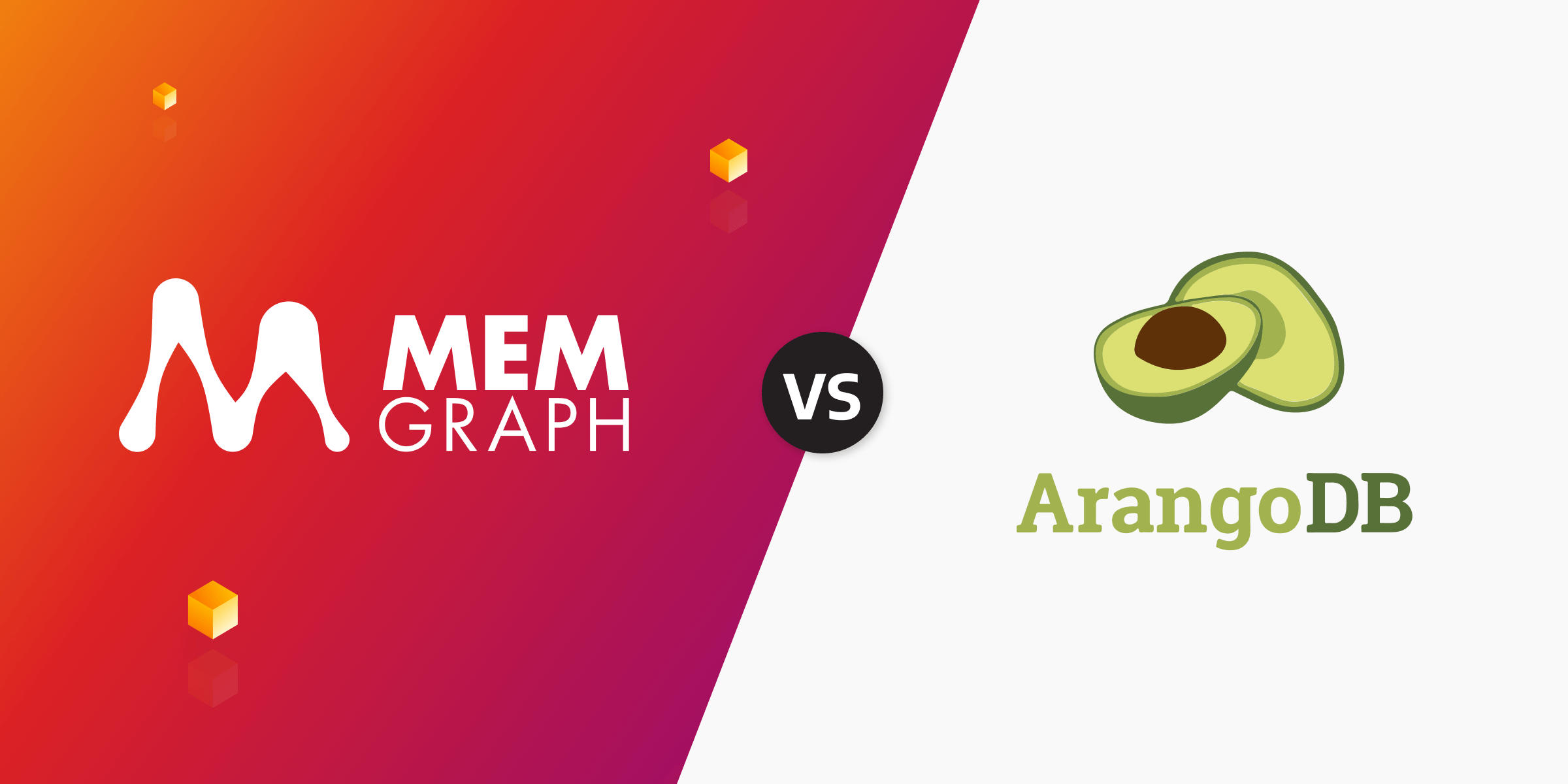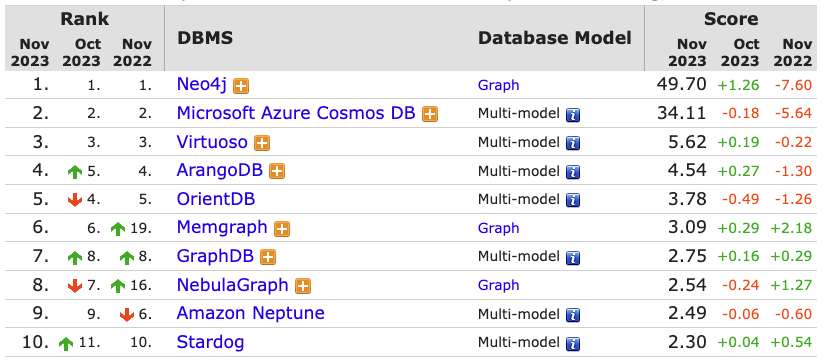
ArangoDB vs. Memgraph
In the dynamic landscape of database management systems, choosing the right solution for your specific needs is crucial. This time, the spotlight is on ArangoDB and Memgraph. Both are powerful databases, but they differ in various aspects that can significantly impact your application's performance. In this blog post, we'll dive into a comparison of ArangoDB and Memgraph, highly ranked databases on DB Engines, exploring their features, strengths, and potential use cases.

About Memgraph and ArangoDB
ArangoDB is a multi-model database that can handle different types of data like graphs, documents, and key-values. It provides a flexible solution for storing, querying, and manipulating data within a single database, without needing separate systems.
Memgraph is a powerful graph database offering advanced analytical insights and high performance. It operates entirely in memory, ensuring rapid read and write access, making it the perfect choice for applications that demand quick response time and real-time processing.
Feature comparison
Both Memgraph and ArangoDB are open-source and built in C++. They ensure data consistency and reliability through ACID transactions, even in the face of concurrent transactions or failures. Also, they embrace schema-less data models enabling users to organically evolve data structures over time without the constraints of upfront schema definitions. The strength of both lies in their integration capabilities, establishing connections with widely-used programming languages and frameworks. Despite these commonalities, notable distinctions between the two arise in their data models and query languages, as well as their use cases. Let's delve into these differences.
| Name | ArangoDB | Memgraph |
|---|---|---|
| Primary database model | Document store, Graph DBMS, Key-value store, Search engine | Graph DBMS |
| Open Source | Yes | Yes |
| Implementation language | C++ | C++ |
| Data scheme | schema-free | schema-free and schema-optional |
| Query language | AQL | Cypher Query language |
| ACID transactions | Yes | Yes |
Data model
ArangoDB's multi-model approach provides adaptability for various use cases. This versatility is advantageous for projects requiring a unified solution for different data structures, offering a convenient approach to data management. However, there could be potential performance trade-offs compared to databases specifically designed for dedicated data models.
In contrast, Memgraph focuses on a specialized data model tailored for graph databases and ensures optimal performance for applications that heavily rely on interconnected relationships. Memgraph's built-in graph algorithms and analytics functions simplify complex analyses, saving development time. In addition to numerous essential built-in algorithms, Memgraph provides highly efficient advanced algorithms through its MAGE library. Additionally, Memgraph features a thriving community with documentation, tutorials, and a support channel on Discord, offering valuable assistance and space for shared experiences among graph developers.
Understanding the data model of each database is crucial for developers, as it directly influences how data is structured and queried. The choice between these databases ultimately depends on the nature of the data and the requirements of the application at hand.
Query language
ArangoDB uses the ArangoDB Query Language (AQL), which is similar to SQL but tailored for querying diverse data models. AQL supports joins and graph traversal operations, providing a robust querying capability.
On the other hand, Memgraph employs the Cypher query language, a widely embraced and expressive tool for graph queries. Cypher simplifies the querying and manipulation of graph data with its declarative syntax, especially intuitive for developers familiar with SQL-like structures.
Developers often choose Cypher due to its strong community support and its seamless adaptability when switching to another database vendor. Conversely, working with a multi-model database and AQL may require users to become familiar with various data models and query syntaxes. Each language brings its strengths, and the choice depends on the specific needs and preferences of the users.
Use cases
Memgraph
Memgraph is exceptionally well-suited for real-time graph analytics in diverse scenarios, with standout applications in:
Cybersecurity: Interconnected data is efficiently stored, empowering threat analysts to identify sources, patterns, and chains of malicious attacks.
Fraud Detection: Memgraph is excellent for spotting fraud in real-time by identifying patterns in large sets of data related to activities like money laundering and identity theft.
Knowledge Graph: Integration of different sources of data into one knowledge graph makes it easier for people to collaborate and discover new insights from diverse datasets.
Recommendation Engine: Memgraph models user preferences, item details, and interactions as a graph to provide personalized suggestions using similarity, neighborhood analysis, and collaborative filtering algorithms.
Energy management systems: With Memgraph, it’s possible to manage your energy network systems and provide a stable and reliable service.
Identity and Access Management: Memgraph, as a graph database, empowers developers to build Identity and Access Management (IAM) systems capable of tracking complex permissions and checking access rules in milliseconds at scale.
ArangoDB
ArangoDB offers flexibility in data modeling and supports various models. It excels in document-focused applications and proves effective for tasks requiring swift analytics with complex queries. Some of the potential use-cases are:
Content Management and E-commerce: Its multi-model capabilities make it an excellent choice for building content management systems and e-commerce platforms that often require diverse data structures.
Social Networks and Recommendation Engines: ArangoDB has good graph capabilities, useful in modeling and analyzing social relationships, making it a valuable asset for developing social networks and recommendation systems.
Catalog Management and Knowledge Graphs: ArangoDB is effective in organizing and managing complex product catalogs, document repositories, and knowledge graphs, leveraging its document and graph data models.
Takeaway
In the ArangoDB vs. Memgraph debate, there is no one-size-fits-all answer. The choice between the two depends on your application's specific requirements, the nature of your data, and your performance expectations.
If your application revolves around complex graph relationships and demands fast real-time processing and analytics, Memgraph emerges as the ideal choice. Its specialized focus on graph databases, in-memory operation, and built-in graph algorithms make it exceptionally well-suited for diverse scenarios.
Feel welcome to engage with Memgraph's vibrant community on Discord, where active discussions are ongoing. If you're exploring various graph databases, dive deeper into Memgraph's use cases and recent benchmarks to gain insights into how it stacks up against alternative solutions. See you on Discord !